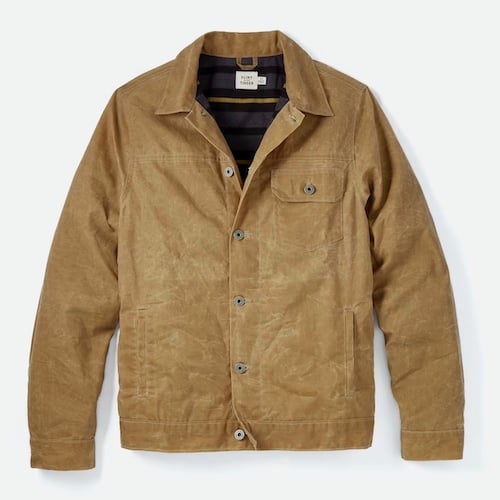How to Wax a Jacket: A Step-By-Step Guide to Waterproof Cotton
Summer’s over, you open your closet to bring your favorite waxed canvas jacket back into your rotation, but something’s off.
It’s lost some of its sheen since you purchased it and it doesn’t repel water as well either. You’ve dutifully worn your jacket so well that the wax has worn away. (Or it’s begun to — it’ll start at the elbows.)
There’s more to waxed jackets than the timeless, rugged, outdoorsman aesthetic: the wax coating keeps rain and wind off of you. Fortunately, you don’t have to buy a new one; you just need a can of wax and a bit of elbow grease.
Today, we’re going to talk about how to re-wax your canvas jacket, when you should do it, and what kinds of products to use.
Key Takeaways:
Waxing a jacket is straightforward, but very time consuming. Most guys outsource it but some find it enjoyable.
- Spot clean your jacket with cold water. If it’s soiled or smelly, spot clean with Otter Wax Canvas Cleaner.
- Get some fabric wax and heat it with a hot air gun or hair dryer (you can also leave it in a container of boiled water.)
- Rub melted wax into the fabric with a sponge or rag.
- Blot away any extra wax that’s not getting absorbed after a few minutes.
- Dry the jacket overnight and enjoy!
A truly iconic waxed canvas jacket that's American made with American materials, it's perfect for work and play — plus it comes in 8+ colors and two fits.
When to Rewax Your Jacket
Like conditioning your leather boots, re-waxing depends on how often you use your jacket.
And the more often you use it, the more often you’ll have to re-wax it. It’s really that simple.
What’s important is to notice if your jacket is not repelling water anymore, which is the biggest sign that you should re-wax it already.
Thankfully, there are also visual indicators. The areas where the wax has worn out tend to appear lighter compared to the areas that still have enough wax in them. These areas also often move more, such as the sleeve, the hem, the elbow, and under the arms. If you throw some water on the elbow and your skin gets wet, it’s a sign to start waxing.
According to the team from Huckberry.com‘s gear lab, there’s a simple way to test if your jacket needs a fresh coat of wax:
- Spray your jacket with water.
- After a few minutes, check if the water has soaked into the jacket
- If the water soaked into the fabric, seams, or creases, it’s time for a rewaxing.
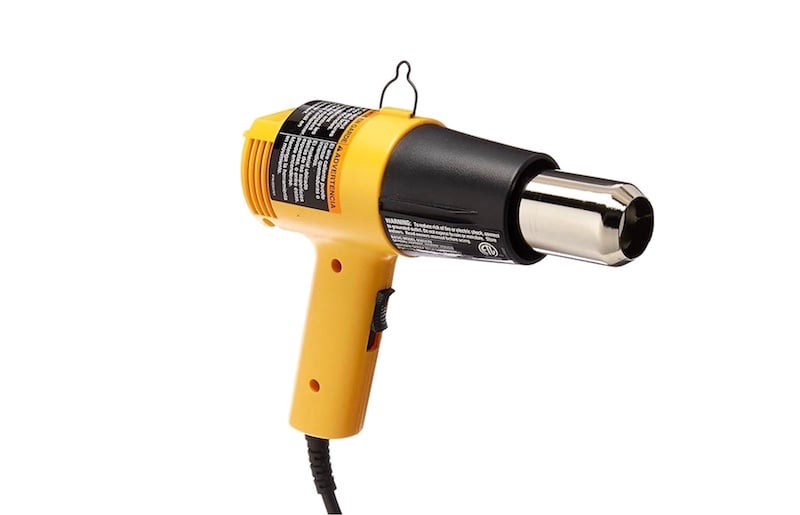
Supplies for Waxing a Jacket
Ready to get waxin’?
You’re gonna need the following for this project:
- Wax (in bar form or jar form)
- A heat gun or hair dryer
- A sponge or rag
- Dishwashing gloves (optional)
You might feel like a heat gun is overkill, but as you can see in our video, it makes it simpler and easier to create a consistent, smooth, and effective coating of wax. Plus it cuts down on the time you’ll spend reheating the wax as your project wears on.

The Right Wax for Waxing Cotton
Before we get into the types of wax, let’s talk first about the forms of wax you’ll choose from: canned wax and bar wax.
Canned wax comes in a can and tends to be softer than bar wax. Some advantages are that it’s easier to store, it’s easier to spread, and it’s easier to heat without making a mess. (Folks often place the can in a bowl of hot water.)
In the video guide to waxing a jacket at the start of this article, you can see us using canned wax from Tom Beckbe.

Bar wax looks like a soap bar; you soften one end with heat and then rub it onto the fabric. You could call it easier to apply than canned wax because you can avoid using a sponge, and you could argue that it’s cleaner to use because it’s a harder substance and won’t drip or run as much.
To see a demonstration of bar wax, check out our video where we use it to wax suede boots.
The types of wax can generally be categorized as either petroleum-based, such as paraffin, or organic ones like beeswax and plant-based blends.
Paraffin
It’s a petroleum byproduct, so there’s debate as to whether or not it’s toxic when heated indoors. It seems unlikely that you’ll get it hot enough, but use it in a well ventilated area to be safe.
Paraffin is the most common wax used on fabrics: Tom Beckbe, Filson, and Barbour use paraffin on their jackets.
Organic
Organic wax for waterproofing is usually a blend of beeswax and plant-based waxes and oils, sometimes from the food industry, and they’re typically non-toxic.
Brands tend to keep their formula a secret, though two popular brands out there using organic wax are Martexin (used on Flint and Tinder’s Waxed Trucker) and Otter Wax.
A truly iconic waxed canvas jacket that's American made with American materials, it's perfect for work and play — plus it comes in 8+ colors and two fits.
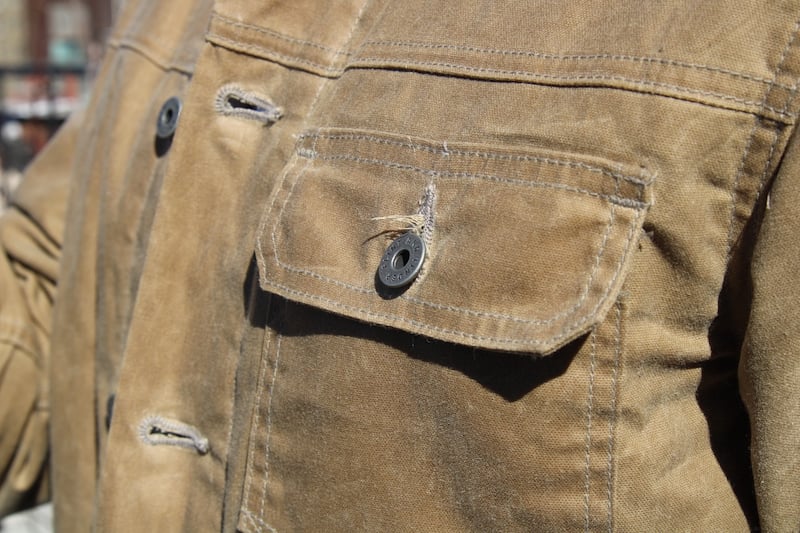
How to Wax Your Jacket
Like calorie counting, meditation, and all grand self improvement projects, waxing a jacket is simple but not easy. Basically, it’s very time consuming and you’ll want to devote an afternoon to the process. Some guys love it, finding it meditative or a nice way to keep their hands busy while listening to music or podcasts.
Spot Clean Your Jacket
Although many argue you shouldn’t clean waxed jackets at all, it’s good to perform a little maintenance so that you’re not trapping dirt under the new layer of wax. Technically, leaving dirt in the fabric and stitching will speed up their degradation.
Soaps, normal detergents, and washing machines are generally not recommended when cleaning waxed canvas. Instead it’s best to use a specially formulated cleaner like Otter Wax Canvas Cleaner.
- Apply a pea-sized amount of soap on the area that needs cleaning.
- Dip a soft brush or a lint-free rag into warm water.
- Clean the area, rinse off the brush, and repeat until the stain’s gone.
- If the stain is stubborn, switch to a stiff bristled brush.
- Air dry the jacket overnight.
[Learn more: How to Clean a Waxed Jacket]

Melt the wax
If you’re using canned wax, you can either sit the can in a bowl of hot water or you can use a heat gun to melt it. (You don’t want to microwave the tin can.)
If you’re using bar wax, heat one side only while you hold it on the other.
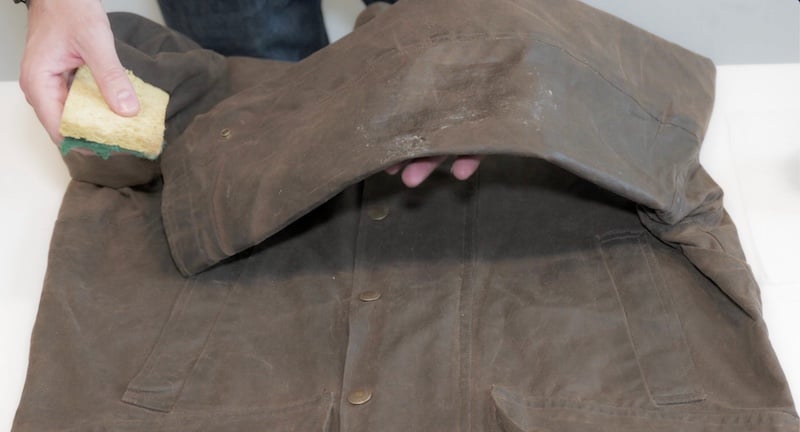
Apply the melted wax
If you’re using canned wax, dip your sponge or rag in the wax and rub that on the fabric. You can either go in circles or linear strokes.
If you’re using bar wax, just rub it onto the fabric. Don’t heat too much of the bar so you still have a firm and comfortable grip on it.
You can always wait until the next day to scrape off unabsorbed wax, but it’ll be easier if you wipe off or redistribute that extra wax while it’s soft.
After you apply the wax on the jacket, use the heat gun on it so the wax absorbs faster and spreads more uniformly.

Excess wax will tend to be unabsorbed after applying heat, and you can either spread it to other areas or blot it out. If wax is building up, it means it’s time to move to another part of the jacket.
If you notice the areas that still have a wet sheen after heating, those areas have excess wax melted on them. You can always wait until the next day to scrape it off, but it’ll be easier if you wipe off or redistribute that extra wax while it’s soft.

Dry your waxed jacket overnight
Once you’re done re-waxing your jacket, it will still be slightly damp to the touch and will still have a wet look to it.
Before you use it right away, let it hang dry overnight first to let the wax set. Feel free to hang it in your bathroom or outside — whichever environment is cooler!
A truly iconic waxed canvas jacket that's American made with American materials, it's perfect for work and play — plus it comes in 8+ colors and two fits.

Why Should I Wax My Jacket?
- Improves water resistance
- Improves aesthetic
We wrote a whole article outlining the benefits of waxed jackets, but the long and short of it is that adding wax is an old fashioned — and still effective — way to make cotton more water resistant and (to a lesser extent) wind resistant.
Cotton is a wonderful fabric but one if its downsides is that it loves to soak up water and it takes a long time to dry. (Remember the last time you tried to air dry your jeans?)
Densely woven cotton like canvas or twill, which are typically the forms used for these kinds of jackets, are very hard wearing and resistant to abrasion and tearing. But again, it’s very dense with cotton, so these kinds of weaves take even longer to dry than a standard t-shirt.
Applying a layer of wax adds water resistance because it’s hydrophobic, creating a barrier around the fabric that water beads off of.
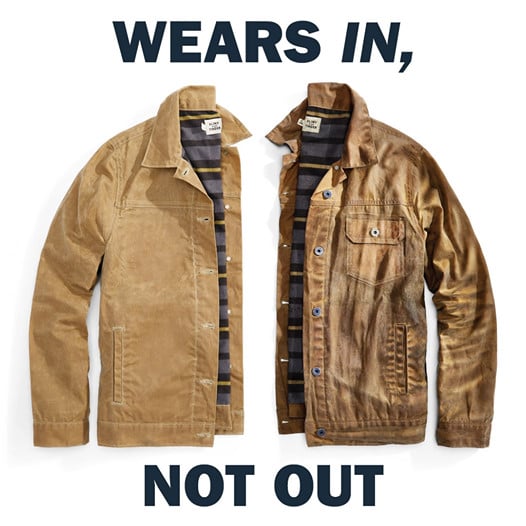
Waxed cotton also looks damn cool. Called a “patina cheat code” by our pal Carl Murawski, it forms creases and color permutations that make the jacket look worn in, but in an attractive, dynamic way.
That’s the beauty of canvas, leather, and denim: it looks better as it ages. Waxing your cotton helps to speed up the process and bring a new dimension to your waxed canvas bag or jacket’s aesthetic.
Maybe you don’t prioritize aesthetics, but like we said, it also keeps the water off. Win/win.
[Learn more: How Waterproof Are Waxed Jackets?]
Wax On, Wax Off — Wax On, Again
And that’s it!
To re-wax your canvas jacket, you’d need wax, heat, and gumption.
Take your time and enjoy the process of maintaining waxed canvas, which you might actually find to be quite satisfying.

